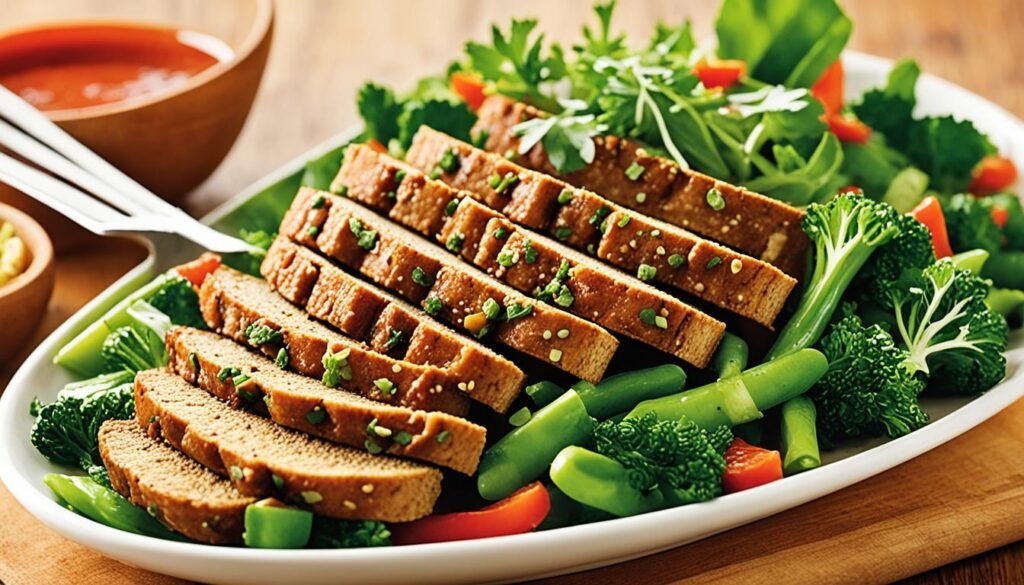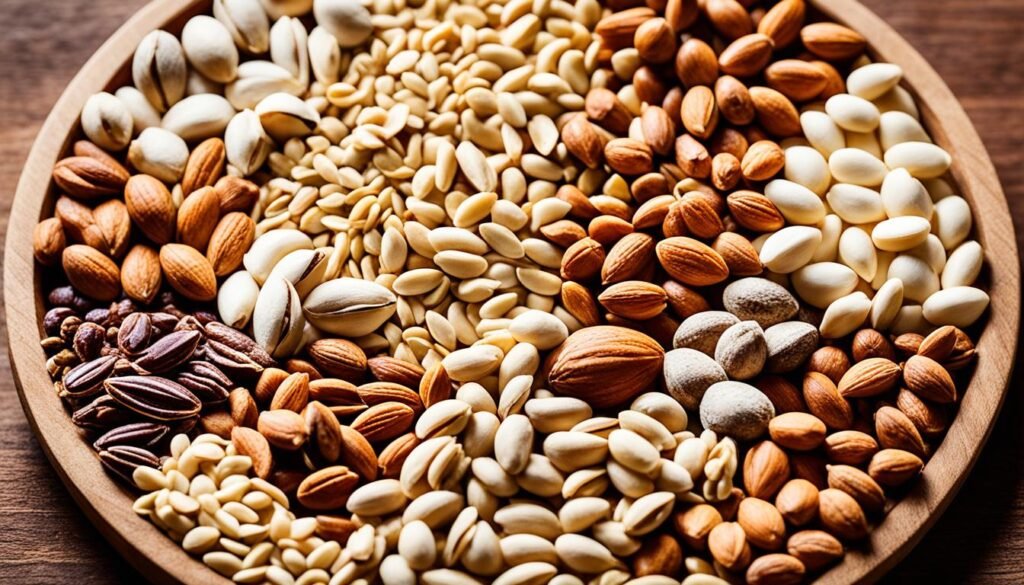Do you know that seitan, a plant-based food, is packed with protein? It has a whopping 25 grams of protein for every 3.5 ounces you eat. This protein content makes it one of the top sources of plant-based proteins. Now, let’s dig into the list of the top 10 sources of plant proteins.
The top 10 plant-based proteins are amazing. They start with Seitan at the top, offering 25 grams of protein for every 100 grams you eat. Then there’s Tofu, Tempeh, and Edamame, with 12 to 20 grams for the same serving size. It continues with others like Lentils, Beans, and Nutritional Yeast. Green Peas, Spirulina, and Quinoa are among the top 10 as well.
Introduction to Plant-Based Protein Sources
Many think plant-based diets lack protein, but that’s wrong. Foods like veggies, fruits, grains, nuts, seeds, and legumes have protein. This protein is key for muscle health, immune function, and good health overall. So, a well-planned plant-based diet can offer enough protein and nutrients for a balanced diet.
Misconceptions About Plant-Based Diets
Some say plant-based diets don’t have enough protein. But, many plant foods are rich in protein. For example, you can get protein from seitan, tofu, lentils, and quinoa. So, there are plenty of high-protein options in the plant world.
Importance of Protein in a Balanced Diet
Protein is crucial for the body. It builds and repairs tissues, keeps muscles strong, and helps the immune system. Getting enough protein, whether from plants or animals, is important for health.

Seitan: The High-Protein Wheat Meat Alternative
Seitan is often called wheat meat or wheat gluten. It’s a top pick for people not eating meat, offering 25 grams of protein per 100 grams. It looks and feels like meat when cooked, which makes it a favorite among vegetarians and vegans. Besides being a protein powerhouse, seitan also comes with selenium. It inlcudes iron, calcium, and phosphorus in small amounts.
The process for homemade seitan calls for 175 grams of extra firm tofu, 200 grams of canned white beans, and 190 grams of vital wheat gluten. Add in garlic powder, onion powder, and more spices for flavor. You can steam seitan cutlets wrapped in foil for 15 minutes. Or, use a pressure cooker for a faster result. This recipe makes 8 servings.

Tofu, Tempeh, and Edamame: Soy-Based Powerhouses
Tofu, tempeh, and edamame come from soybeans. They provide all essential amino acids. These foods are rich in protein, iron, and calcium, making them great for plant-based diets.
Tofu: A Versatile and Nutrient-Dense Option
Tofu offers about 15g of protein in a 4oz serving. It has a mild taste and can take on other flavors well. This makes tofu a go-to for many recipes, like stir-fries and desserts.
Tempeh: A Probiotic-Rich Soy Product
Tempeh has 15g of protein in a 100g serving. Its special preparation adds probiotics and good bacteria. It’s an excellent choice for those on a plant-based diet.
Edamame: Immature Soybeans Packed with Protein
Edamame gives you 8.5g of protein in just a half-cup. Because they’re immature soybeans, they’re easy to snack on. You can also add them to salads or stir-fries for a protein boost.

Lentils: A Fiber-Filled Protein Source
Lentils provide about 18g of protein in each cooked cup. They are a top choice for plant-based protein. Not only that, lentils give you a big dose of fiber, more than half of what you need in a day. They are also filled with folate, manganese, and iron, along with other good-for-you plant compounds.
Nutritional Profile of Lentils
Lentils are rich in vitamins and minerals, making them very nutritious. They are high in protein and fiber, and offer plenty of folate, manganese, and iron. These legumes work well in many plant-based recipes, helping you maintain a healthy diet.
Cooking and Incorporating Lentils into Meals
You can easily add lentils to many meals like stews, curries, and salads. They even go well with rice dishes. Lentils have a mild taste that pairs nicely with other foods. Their texture is hearty, adding a satisfying feel to your food. This, combined with their rich nutrient content, makes lentils excellent for anyone, especially those who prefer plant-based diets.

10 Best Sources of Plant-Based Proteins From Highest to Lowest
The top 10 sources of plant-based proteins vary from most to least. These include:
- Seitan comes first. It has around 25 grams of protein in a 3.5-ounce serving. This makes it a top choice for protein from plants.
- Tofu, tempeh, and edamame have 12–20 grams of protein in each 3.5 oz. This group is a strong protein source too.
- Lentils give you 18 grams of protein per cooked cup. Plus, they offer over half of your daily need for fiber in just a cup. They’re a great choice for energy and protein.
- Beans offer nearly 15 grams of protein per cooked cup. They’re not only protein-rich but also full of complex carbs, fiber, iron, and more.
- Nutritional yeast adds 8 grams of protein and 3 grams of fiber with each half-ounce. It’s packed with essential vitamins and minerals too.
- Spelt and teff are next, with 10–11 grams of protein in a cooked cup. They bring nutrients like complex carbs, iron, and B vitamins to the table.
- Hemp seeds give you 9 grams of protein in a 3-tablespoon serving. They’re rich in essential minerals and omega fatty acids as well.
- Green peas contain almost 9 grams of protein per cooked cup. They’re also full of fiber, vitamins, and minerals.
- Spirulina, a superfood, offers 8 grams of complete protein in every 2 tablespoon serving. It’s also a hefty source of iron and other key nutrients.
- Amaranth and quinoa have 8–9 grams of protein each in a cooked cup. They stand out as complete protein sources, packed with essential minerals and complex carbs.
By mixing these plant foods into your diet, vegetarians and vegans can get a lot of protein. This makes for a well-rounded, healthy eating plan.

Nuts and Seeds: Portable Protein Powerhouses
Nuts and seeds offer a great source of plant-based protein. They are easy to take with you and use in many dishes. This adds protein to your meals.
Almonds: A Nutrient-Dense Snack
Almonds shine as a top choice for protein, with 16.5 grams in each half cup. They’re not just about protein; almonds also bring healthy fats, fiber, and key vitamins and minerals. This makes them a smart snack.
Hemp Seeds: A Complete Protein Source
Hemp seeds stand out by offering complete proteins, with 9 grams of protein in 3 tablespoons. They also hold a good amount of omega-3 and omega-6 fatty acids. These fats are important for your health and well-being.
Chia Seeds: Tiny but Mighty
Chia seeds are small but mighty, giving 2 grams of protein per tablespoon. These seeds are great for enhancing the nutrition of food like smoothies, oatmeal, puddings, and more.

Quinoa and Amaranth: Gluten-Free Protein Grains
Quinoa and amaranth are called pseudocereals. This means they’re not true grains, but they act like them. They are rich in proteins and perfect for those on a vegetarian or vegan diet.
Quinoa: A Complete Plant-Based Protein
Quinoa is a complete protein, having all essential amino acids. A cup of cooked quinoa gives you 8 grams of protein. It’s also high in fiber and many important nutrients.
Amaranth: An Ancient Grain with Modern Appeal
Amaranth is another protein-rich pseudocereal. A cooked cup gives you 9 grams of protein. It offers a lot of fiber, iron, and other nutrients. This ancient grain has a unique nutty taste, adding a special flavor to dishes.
Since both are gluten-free, they’re great for those avoiding gluten. You can use quinoa and amaranth in various recipes, like salads, pilafs, and breakfast meals. They’re versatile and a good addition to any meal.
Nutritional Yeast: A Vegan’s Best Friend
Nutritional yeast is a deactivated yeast strain. It’s well-loved in the vegan and vegetarian circles. This food is not only full of protein, but it also has lots of essential nutrients for those on a plant-based diet.
Nutritional Benefits of Nutritional Yeast
A 2-tablespoon serving of nutritional yeast gives you 8 grams of protein. It’s also rich in vitamins and minerals like zinc, magnesium, and B vitamins. You also get important nutrients like copper, manganese, and fiber, which there are 3 grams of in each serving.
Using Nutritional Yeast in Cooking
This yeast has a savory, “cheesy” taste. Many use it to make plant-based dishes better and healthier. You can sprinkle it on popcorn, stir it into pasta sauces, or use it in salad dressings. It even works well to create dairy-free cheese sauces or to top dishes like baked potatoes and vegetables.
Spirulina: A Nutrient-Dense Superfood
Spirulina is a blue-green algae known for its rich nutrients. Just two tablespoons of its powder contain 8 grams of plant-based protein. It also boasts essential minerals and vitamins, making it a top superfood.
Health Benefits of Spirulina
Studies show spirulina provides many health perks. It is rich in antioxidants, fights inflammation, and might ward off cancer. This algae contains carotenoids that can boost your immune system and eyesight.
The fatty acids in spirulina might alleviate depression, anxiety, and enhance brain health. They also benefit the heart.
Incorporating Spirulina into Your Diet
The earthy and slightly sweet flavor of spirulina blends well with plant-based dishes. You can mix a tablespoon into your morning smoothie. It’s also great sprinkled on salads, soups, and popcorn.
For beginners, starting with small doses is a good idea. You can work your way up to 10 grams a day over six months.
Conclusion
Plant-based diets are rich in protein and other key nutrients, perfect for a healthy life. Foods like seitan, tofu, lentils, nuts, and seeds offer plenty of protein. For more nutrition, superfoods like spirulina and nutritional yeast are great additions.
With the right planning, a plant-based diet can meet all your protein needs. It helps to focus on natural, less processed plant foods. This way, you get a wide range of amino acids, vitamins, and minerals for good health.
A carefully planned plant-based diet is all you need for a vibrant life. Enjoy a wide variety of plant proteins for a tasty and nourishing lifestyle.

I don’t think the title of your article matches the content lol. Just kidding, mainly because I had some doubts after reading the article.
Your point of view caught my eye and was very interesting. Thanks. I have a question for you.